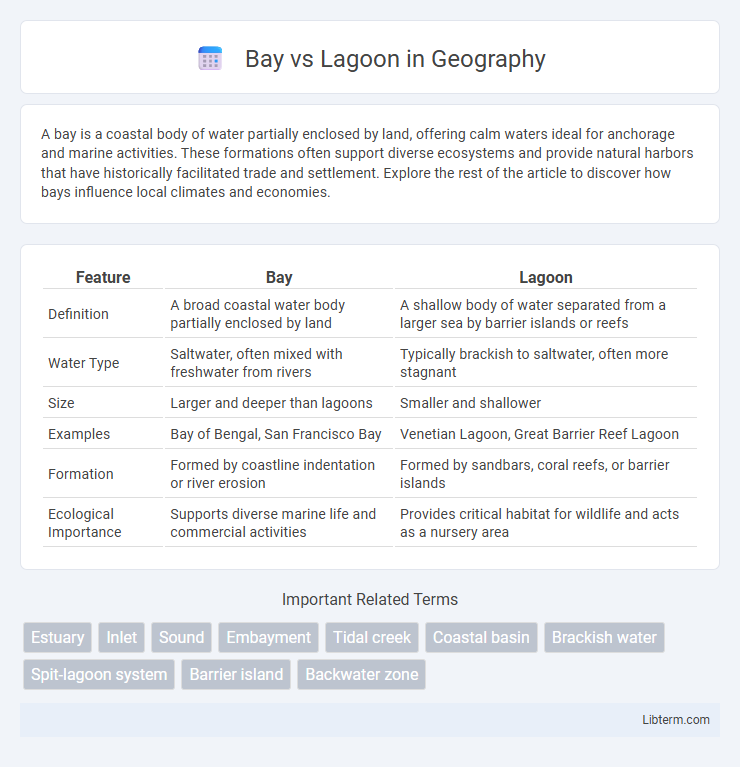A bay is a coastal body of water partially enclosed by land, offering calm waters ideal for anchorage and marine activities. These formations often support diverse ecosystems and provide natural harbors that have historically facilitated trade and settlement. Explore the rest of the article to discover how bays influence local climates and economies.
Table of Comparison
| Feature | Bay | Lagoon |
|---|---|---|
| Definition | A broad coastal water body partially enclosed by land | A shallow body of water separated from a larger sea by barrier islands or reefs |
| Water Type | Saltwater, often mixed with freshwater from rivers | Typically brackish to saltwater, often more stagnant |
| Size | Larger and deeper than lagoons | Smaller and shallower |
| Examples | Bay of Bengal, San Francisco Bay | Venetian Lagoon, Great Barrier Reef Lagoon |
| Formation | Formed by coastline indentation or river erosion | Formed by sandbars, coral reefs, or barrier islands |
| Ecological Importance | Supports diverse marine life and commercial activities | Provides critical habitat for wildlife and acts as a nursery area |
Introduction to Bays and Lagoons
Bays are coastal bodies of water partially enclosed by land, providing sheltered areas where the sea meets the shore, often featuring curved coastlines and varying depths. Lagoons are shallow, saline or brackish water bodies separated from larger bodies of water by barrier islands, coral reefs, or sandbanks, typically exhibiting limited water exchange with the open sea. Both bays and lagoons serve critical ecological roles, supporting diverse marine habitats and influencing coastal environments.
Defining Bays: Key Characteristics
Bays are coastal bodies of water partially enclosed by land, typically featuring a wide mouth that allows significant water exchange with the ocean. They possess calmer waters compared to open seas, often supporting diverse marine ecosystems and serving as natural harbors. Bays vary in size and shape but are distinguished by their broad openings and relatively shallow depths compared to lagoons.
What is a Lagoon? Essential Features
A lagoon is a shallow body of water separated from a larger sea or ocean by a barrier such as a sandbar, coral reef, or barrier island. Essential features of lagoons include their calm, brackish water and limited wave action due to natural barriers, which create unique ecosystems supporting diverse aquatic species. Unlike bays, lagoons are typically enclosed, making them crucial habitats for migratory birds and marine life.
Formation Processes of Bays
Bays typically form through coastal erosion where softer rock is worn away by wave action, creating an indentation along the shoreline. In some cases, bays also develop from tectonic activity, such as the sinking of land or rift valleys flooded by seawater. The natural accumulation of sediment can subsequently modify bay shapes, distinguishing them from lagoons, which are primarily enclosed by barrier islands or coral reefs.
How Lagoons Are Formed
Lagoons are formed when coastal barriers such as sandbars, barrier islands, or coral reefs enclose a shallow body of water, separating it from the open ocean. This natural enclosure creates calm, often brackish water that supports unique ecosystems and sediment accumulation. Unlike bays, which are typically formed by tectonic activity or erosion and have wider openings to the sea, lagoons have restricted water exchange with the ocean due to their physical barriers.
Differences Between Bays and Lagoons
Bays are coastal inlets partially enclosed by land with a wide opening to the sea, typically formed by the erosion of coastlines or tectonic activity, while lagoons are shallow bodies of water separated from larger bodies of saltwater by barrier islands, coral reefs, or sandbanks. Bays often have deeper waters and support larger ship navigation, whereas lagoons are generally shallow, promoting unique ecosystems with brackish water conditions. Unlike bays that form natural harbors, lagoons primarily function as protected habitats for diverse flora and fauna due to their enclosed and calm waters.
Ecological Importance of Bays
Bays serve as critical ecological zones that support diverse marine life by providing sheltered habitats and breeding grounds for numerous species. Their unique conditions foster nutrient-rich waters that enhance productivity and sustain complex food webs vital for fisheries and coastal ecosystems. Preservation of bays is essential for maintaining biodiversity, water quality, and resilience against climate change impacts.
Biodiversity in Lagoon Ecosystems
Lagoon ecosystems support exceptional biodiversity due to their unique mix of saltwater and freshwater, creating diverse habitats ideal for various marine and bird species. Nutrient-rich waters in lagoons promote abundant plant and animal life, including seagrasses, mollusks, fish, and migratory birds. Unlike bays, lagoons often serve as critical nursery grounds for endangered species, enhancing ecological balance and resilience.
Human Impact on Bays and Lagoons
Human activities significantly affect bays and lagoons through pollution from industrial discharge, agricultural runoff, and urban development, leading to habitat degradation and reduced water quality. Coastal construction and land reclamation often alter natural water flow, causing erosion and loss of biodiversity in both ecosystems. Overfishing and tourism further stress these areas, disrupting ecological balance and threatening marine species.
Famous Bays and Lagoons Around the World
Famous bays such as San Francisco Bay, Guanabara Bay in Brazil, and the Bay of Bengal showcase expansive coastal inlets with deep waters ideal for ports and marine biodiversity. Iconic lagoons like the Blue Lagoon in Iceland, Bora Bora's lagoon in French Polynesia, and the Venice Lagoon in Italy highlight shallow, calm waters separated from the ocean by reefs or barrier islands, often supporting unique ecosystems and tourism. Differentiating bays and lagoons lies in their size, depth, and ecological significance, with bays typically larger and deeper while lagoons maintain calm, protected environments rich in marine life.
Bay Infographic

 libterm.com
libterm.com